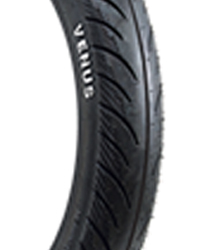
TYRE CARE
The anatomy of a tyre
The composition of tyres involves intricate substances such as rubber and silicon, strengthened by layers of nylon, polyester, or steel cord belts. The crucial component responsible for traction is the tread, which varies in patterns consisting of a blend of ribs, blocks, lugs, and other elements.
Lugs
The primary component of the tread is the lug, which comprises the voids extending horizontally across the tire from the shoulder. These voids serve the dual purpose of enhancing traction and facilitating the drainage of water from beneath the tire. Tyres with a lug pattern, characterized by an abundance of lugs, provide excellent traction and are commonly employed in off-road vehicles as well as for the drive wheels of trucks and buses.
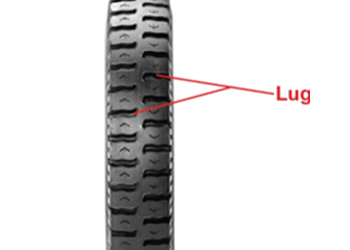
Lugs– example shown on the ZESS ROADRUN HR LCV TYRES
Ribs
Circumferential ribs or contact bars are present along the circumference of the tire tread, separated by grooves. They play an important role in enhancing steering precision and braking efficiency. Tyres with a rib pattern exhibit excellent directional stability, making them suitable for the steering wheels of trucks and buses.
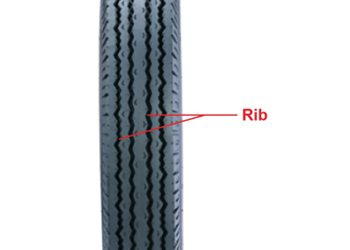
Ribs – example shown on the ZESS SPARK LCV TYRES
Blocks
Blocks are created at the intersections of lugs and grooves. Tyres with a block pattern exhibit commendable traction and effective water dispersal, making them ideal for winter conditions and off-road vehicles.
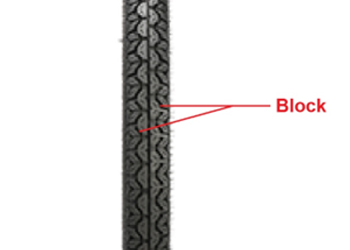
Blocks – example shown on the ZESS SPRINTER 2W TYRES
Sipes
Additional void elements in the tire pattern encompass sipes and dimples. Sipes refer to the narrow voids and channels found on the tire lugs, typically around 0.3-1.5 mm in depth. They play a crucial role in enhancing the tire's traction on wet surfaces and snow. Furthermore, they aid in diverting water away from beneath the tire, thereby reducing the risk of hydroplaning.
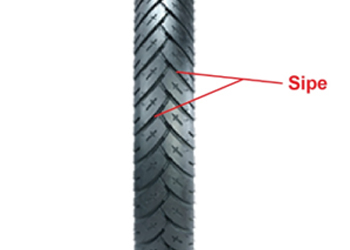
Sipes – example shown on the ZESS RUNWAY HR 2W TYRES
Dimples, on the other hand, are small voids occasionally present on the lugs to improve grip and facilitate tire cooling. While an increased number of voids can reduce a tire's grip on dry surfaces, it enhances performance on wet surfaces. Consequently, the quantity of voids varies depending on the tire's intended purpose, with specific wet or snow tyres often featuring a greater number of tread voids.
Checking correct inflation
Regularly monitor tire pressures is extremely important. It is vital to maintain appropriate tire pressure for safety and to achieve optimal mileage. Uneven, overinflated, or underinflated tyres can result in reduced grip, leading to compromised braking and cornering performance, premature tire wear, and increased fuel consumption.
Ensure that tire pressures align with the manufacturer's recommendations specific to your vehicle. These recommendations can be found on your vehicle itself or in the accompanying handbook. Additionally, it is important to adjust tire pressures according to the amount of load your vehicle is carrying.
Maintaining your tyres
You can ensure optimal mileage, safe performance, and excellent handling of your tyres by adopting a few simple habits. Here are three straightforward rules to get the most out of your ZESS tyres.
- Regularly rotate your tyres.
Between the front and rear axles, perform tire rotations every 5,000 to 10,000 kilometers to ensure even wear across all tyres.
- Cultivate good driving habits.
Avoid excessive speeding, abrupt braking, and sideways sliding, as these behaviors can decrease tire lifespan and compromise safety.
- Verify proper wheel alignment and balancing.
Ensure your vehicle's steering and suspension components are correctly aligned. If you notice excessive vibrations or pulling to one side, consult a professional at a Zess Tire dealer to assess and address any alignment issues.
By following these simple guidelines, you can maximize the lifespan, safety, and overall performance of your ZESS tyres.
Checking tread depth - seeing when to replace your tyres
To ensure the safety, performance, and efficiency of your vehicle, it is crucial to determine when your tyres need to be replaced. Here are two simple methods to assess if your ZESS tyres have worn out and require replacement:
- Identify tread wear indicators:
These are raised bars made of durable rubber that run across two parallel treads. They may be difficult to detect on new tyres, but as the tread wears down, the tread wear indicators become more visible. Once these bars align with the tread surface, it indicates that your tire has worn out and should be replaced.
- Measure tread depth:
Take a ruler and place it within one of the tread grooves of your tire. The measurement should be above 1.6mm. If the reading is 1.6mm or below, it is time to replace the tire. Repeat this step in multiple locations around the tire for accuracy.
Worn-out tyres significantly increase the risk of accidents, as they have reduced braking capability and are prone to losing grip, especially during fast or sharp cornering. For the sake of your safety and that of your passengers, promptly replace your tyres when they are worn out by visiting a ZESS dealer.
By following these guidelines, you can ensure optimal safety and performance by replacing your ZESS tyres when necessary.
The right tyres for the right axles
Selecting the appropriate tyres is crucial, with rib tyres being suitable for steer axles and lug or blocker hybrid tyres recommended for drive axles. When performing tire rotations, it is essential to ensure that the correct tire type remains on each axle.
Choosing bias versus radial tyres
Finding the ideal Zess tyres for your vehicle is a straightforward process. Consider the following essential factors to ensure you select the most suitable ZESS tyres:
- Bias tyres feature robust sidewalls, making them a preferred choice for mining, off-road, and rough surface conditions.
These tyres have self-cleaning treads that effectively release mud and other foreign objects, maintaining excellent traction. The softer rubber compounds and reinforced sidewalls of bias truck tyres offer exceptional performance in challenging off-road environments, such as farming and mining.
- Radial tyres are well-suited for paved roads and highways, offering versatility and superior road handling at high speeds. These tyres are designed for longevity, precise handling, and a smooth ride, making them a suitable choice for driving SCVs (Small Commercial Vehicles) and LCVs (Light Commercial Vehicles) in urban areas with well-maintained, quality roads.
- Considerations for improved traction: While larger tyres may provide enhanced traction in general, there are alternative methods to improve traction without solely relying on tire size. Installing a traction differential (locker) or a winch with stock truck tyres can be more efficient ways to enhance traction. Keep in mind that opting for larger tyres would require modifications to your vehicle, such as suspension adjustments or gear ratio changes.
By considering these factors, you can select the appropriate ZESS tyres that best suit your specific driving needs and road conditions.
Tyre rotation
Do this every 5,000 to 10,000 kilometres between the front and rear axles to ensure all tyres wear out evenly. Here is a tyre rotation guide for different vehicle configurations.
Suggested tyre rotation for 4x2 vehicles
Direction of rotation is the same, keep tyres on the same axle
Suggested tyre rotation for 6x2 vehicles
Direction of rotation is the same but the wheel position is changed, if the tyres are not fitted on the same day on rear axles
Suggested tyre rotation for 6x4 vehicles
Direction of rotation is the same but the wheel position is changed
Suggested tyre rotation for 8x4 vehicles
Direction of rotation is the same but wheel position is changed
The mixture of these pattern elements gives the pattern type. Different pattern types are better for different types of use.
Rib patterns have ribs running around the circumference of tyre, with grooves in straight lines or parallel S-shaped voids along the axis.
Applications: Typically, these tires are specifically engineered for utilization on firm road surfaces like asphalt and concrete. Their commendable directional stability often makes them an ideal choice for installation on the steering wheels of trucks and buses.
Benefits:
- Excellent directional stability and precise steering control
- Reduced rolling resistance, resulting in enhanced fuel efficiency
- Capable of sustaining high speeds
Factors to consider: Relatively lower grip compared to lug-pattern tires during acceleration or braking on wet roads, making them less suitable for use as drive tires.
Rib pattern
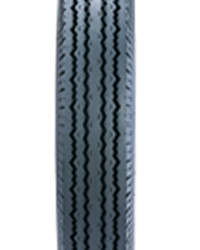
Example of a rib pattern – ZESS SPARK LCV TYRES
This pattern refers to a series of grooves which are perpendicular to the tyre’s circumference.
Applications: Lug tires, known for their exceptional traction, are commonly employed as drive tires for commercial vehicles and 4x4 vehicles designed for off-road conditions.
Benefits:
- Enhanced traction, providing superior grip during braking and acceleration.
Factors to consider:
- Increased noise levels at higher speeds.
- Less fuel efficiency during high-speed driving due to additional rolling resistance.
Lug pattern
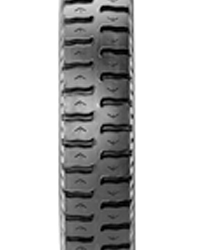
Example of a lug pattern – ZESS ROADRUN HR LCV TYRES
A block shape pattern refers to designs with independent blocks along the tread, separated by a series of interconnected grooves.
Applications: These tires are versatile and suitable for both paved and dirt roads. They can be found on various trucks and buses, and some models can be utilized in multiple positions, including drive and steer axles.
Benefits:
- The central rib of these tires ensures excellent directional control.
- The shoulder lugs provide enhanced braking and driving power.
- The mixed pattern design offers a well-balanced performance, allowing for usage in various positions.
Factors to consider:
- While these tires offer versatility, they may not provide the same specialized performance as dedicated rib or lug patterns in specific drive or steer roles.
Block pattern
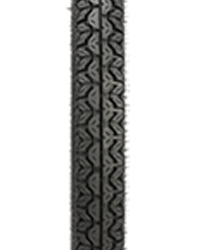
Example of a block pattern – ZESS SPRINTER 2 W TYRES
Directional treads are used primarily for 2-wheeler and for passenger car tyres. They have a series of lateral grooves positioned at the same angle on both sides of the tyre. This creates a ‘direction’ as - correctly fitted - all grooves point forward.
Applications:
Directional tyres are primarily used on 2-wheelers, commonly found in this category of vehicles.
Benefits:
- Excellent traction and braking capabilities, contributing to enhanced safety.
- Effective water dispersal properties, providing stability on wet roads.
- Suitable for fast driving styles, offering reliable performance.
Factors to consider:
- Due to their directional nature, it is important to install these tyres with the correct orientation to optimize their performance.
Directional pattern
